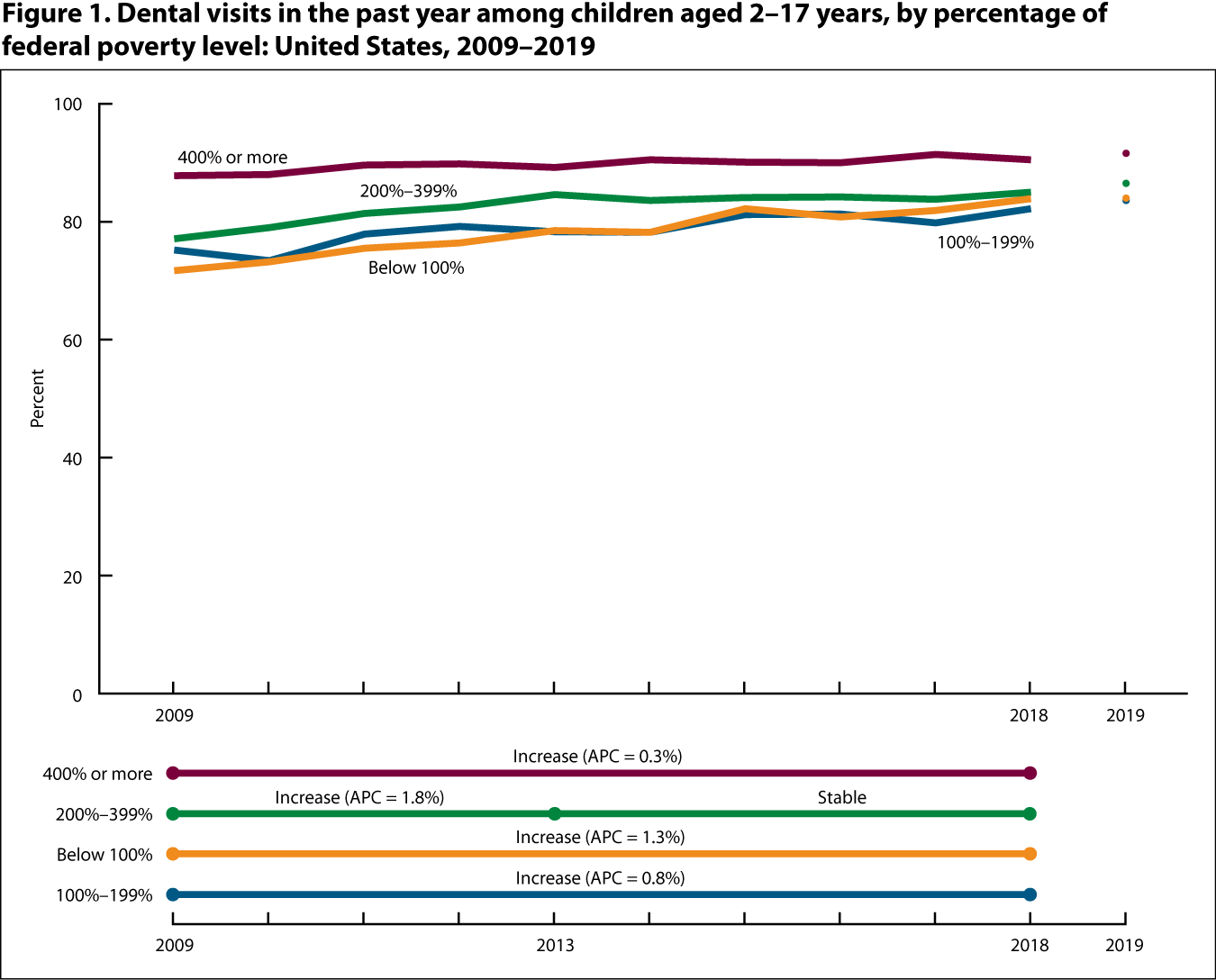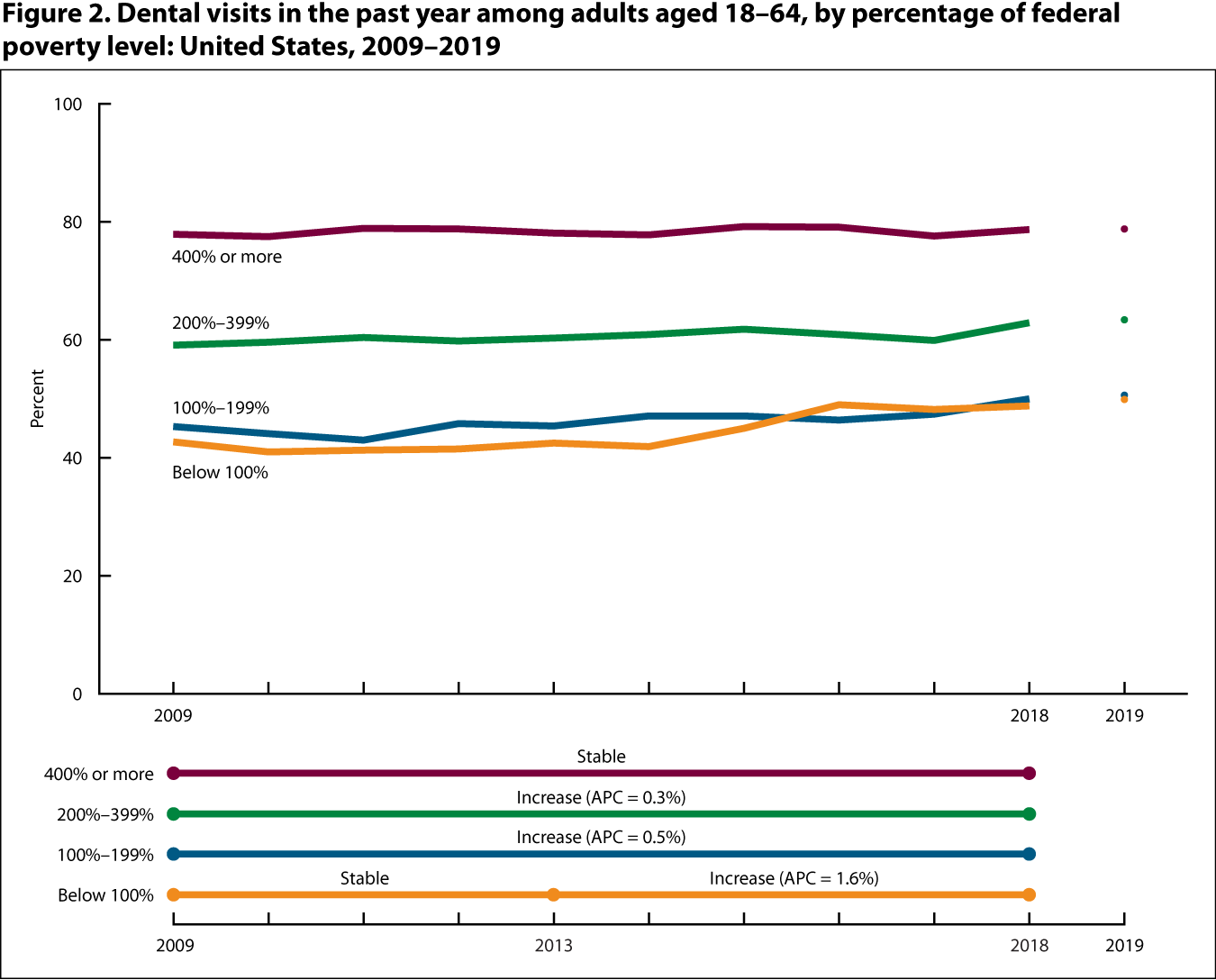Dental Visits
The content on this page was last updated in June 2023. More recent estimates and visualizations may be available from the NCHS Data Query System.
Dental caries, or tooth decay, is one of the most common chronic diseases in children and adults (1). Moreover, most adults show signs of periodontal or gingival diseases (1). Routine dental visits are recommended for people aged 1 year and over and are associated with fewer treatments for oral and craniofacial diseases and conditions and lower costs for dental care (1,2).
Key Findings
Children

The percentage of children aged 2–17 years with a dental visit in the past year increased from 78.4% in 2009 to 82.3% in 2012 and then increased at a slower rate through 2018 to 85.9%. In 2019, 86.9% of children had a dental visit in the past year. See Featured Charts for additional analysis and Notes for more information about analyzing trends using NHIS data.
SOURCE: National Center for Health Statistics, National Health Interview Survey. See Sources and Definitions, National Health Interview Survey (NHIS) and Health, United States, 2020–2021 Table DentCh.
Adults

The percentage of adults aged 18–64 with a dental visit in the past year did not change significantly from 2009 to 2013 and then increased from 61.7% in 2013 to 65.9% in 2018. In 2019, 65.5% of adults aged 18–64 had a dental visit in the past year. See Featured Charts for additional analysis and Notes for more information about analyzing trends using NHIS data.
SOURCE: National Center for Health Statistics, National Health Interview Survey. See Sources and Definitions, National Health Interview Survey (NHIS) and Health, United States, 2020–2021 Table DentAd.
From 2009 through 2019, children living at lower income levels were less likely to have a dental visit in the past year compared with children living at 400% or more of the federal poverty level (FPL).

NOTES: APC is annual percent change. “Stable” refers to no statistically significant trend during the period.
SOURCE: National Center for Health Statistics, National Health Interview Survey. See Sources and Definitions, National Health Interview Survey (NHIS) and Health, United States, 2020–2021 Table DentCh.
- From 2009 to 2018, the percentage of children aged 2–17 years with a dental visit in the past year increased for children living below 100% of FPL (from 71.7% to 83.9%), at 100%–199% of FPL (75.2% to 82.2%), and at 400% or more of FPL (from 87.8% to 90.5%).
- Among children living at 200%–399% of FPL, the percentage of children with a dental visit in the past year increased from 77.1% in 2009 to 84.6% in 2013 and then was stable through 2018 (85.0%).
- In 2019, the percentage of children with a dental visit in the past year was highest for those at 400% or more of FPL (91.6%). No differences were observed between the percentages among those living below 100% of FPL (84.0%) and those living at 100%–199% (83.6%) or 200%–399% of FPL (86.5%).
From 2009 through 2019, adults living below 100% of FPL and at 100%–199% of FPL were the least likely to have a dental visit in the past year compared with adults living at higher income levels.

NOTES: “Stable” refers to no statistically significant trend during the period. APC is annual percent change.
SOURCE: National Center for Health Statistics, National Health Interview Survey. See Sources and Definitions, National Health Interview Survey (NHIS) and Health, United States, 2020–2021 Table DentCh.
- Among adults aged 18–64 living below 100% of FPL, the percentage with a dental visit in the past year did not change significantly from 2009 to 2013 and then increased from 42.5% in 2013 to 48.8% in 2018.
- From 2009 to 2018, the percentage of adults aged 18–64 with a dental visit in the past year increased for those living at 100%–199% of FPL (from 45.3% to 50.0%) and at 200%–399% of FPL (from 59.1% to 62.9%). The percentage did not change significantly over time for adults living at 400% or more of FPL (78.7% in 2018).
- In 2019, the percentage of adults aged 18–64 with a dental visit in the past year was highest for those living at 400% or more of FPL (78.8%), followed by those living at 200%–399% of FPL (62.8%). No differences were observed between the percentages among those living at 100%–199% of FPL (50.6%) and those living below 100% of FPL (49.8%).
Download the data
Dental visits in the past year among children aged 2–17 years, by selected characteristics: United States, selected years 1997–2019
SOURCE: National Center for Health Statistics, National Health Interview Survey.
Dental visits in the past year among adults aged 18 and over, by selected characteristics: United States, selected years 1997–2019
SOURCE: National Center for Health Statistics, National Health Interview Survey.
- Dental visits: For 2019 data, dental visits in the past year are identified by asking adult respondents or the parent of a child respondent how long it has been since they or their child last had a dental examination or cleaning. Before 2019 data, respondents were asked how long it has been since they or their child last saw or talked to a dentist. See Sources and Definitions, Dental visit.
- Poverty level: Based on family income, size, and composition using U.S. Census Bureau poverty thresholds. Missing family income data are imputed. See Sources and Definitions, Family income; Poverty.
- National Institutes of Health. Oral health in America: Advances and challenges [Internet]. Bethesda, MD: National Institute of Dental and Craniofacial Research. 2021. Available from: https://www.nidcr.nih.gov/sites/default/files/2021-12/Oral-Health-in-America-Advances-and-Challenges.pdf.
- American Academy of Pediatric Dentistry. Policy on the dental home. Pediatr Dent 40(6):29–30. 2018.



